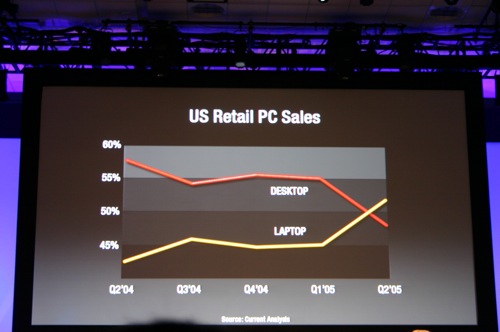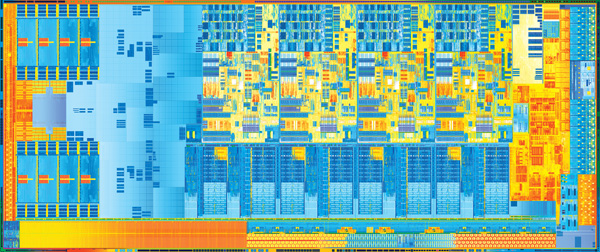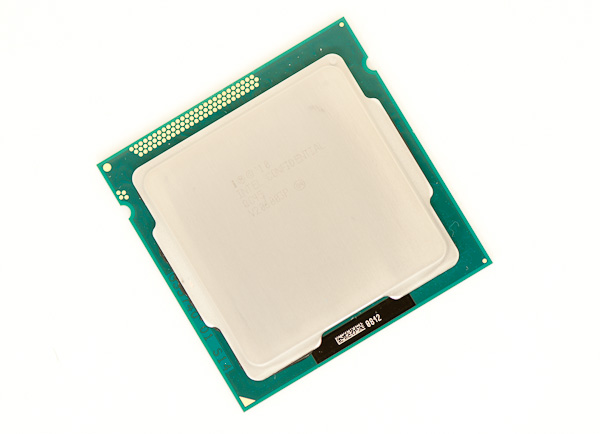The Intel Ivy Bridge (Core i7 3770K) Review
by Anand Lal Shimpi & Ryan Smith on April 23, 2012 12:03 PM EST- Posted in
- CPUs
- Intel
- Ivy Bridge
The times, they are changing. In fact, the times have already changed, we're just waiting for the results. I remember the first time Intel brought me into a hotel room to show me their answer to AMD's Athlon 64 FX—the Pentium 4 Extreme Edition. Back then the desktop race was hotly contested. Pushing the absolute limits of what could be done without a concern for power consumption was the name of the game. In the mid-2000s, the notebook started to take over. Just like the famous day when Apple announced that it was no longer a manufacturer of personal computers but a manufacturer of mobile devices, Intel came to a similar realization years prior when these slides were first shown at an IDF in 2005:
IDF 2005
IDF 2005
Intel is preparing for another major transition, similar to the one it brought to light seven years ago. The move will once again be motivated by mobility, and the transition will be away from the giant CPUs that currently power high-end desktops and notebooks to lower power, more integrated SoCs that find their way into tablets and smartphones. Intel won't leave the high-end market behind, but the trend towards mobility didn't stop with notebooks.
The fact of the matter is that everything Charlie has said on the big H is correct. Haswell will be a significant step forward in graphics performance over Ivy Bridge, and will likely mark Intel's biggest generational leap in GPU technology of all time. Internally Haswell is viewed as the solution to the ARM problem. Build a chip that can deliver extremely low idle power, to the point where you can't tell the difference between an ARM tablet running in standby and one with a Haswell inside. At the same time, give it the performance we've come to expect from Intel. Haswell is the future, and this is the bridge to take us there.
In our Ivy Bridge preview I applauded Intel for executing so well over the past few years. By limiting major architectural shifts to known process technologies, and keeping design simple when transitioning to a new manufacturing process, Intel took what once was a five year design cycle for microprocessor architectures and condensed it into two. Sure the nature of the changes every 2 years was simpler than what we used to see every 5, but like most things in life—smaller but frequent progress often works better than putting big changes off for a long time.
It's Intel's tick-tock philosophy that kept it from having a Bulldozer, and the lack of such structure that left AMD in the situation it is today (on the CPU side at least). Ironically what we saw happen between AMD and Intel over the past ten years is really just a matter of the same mistake being made by both companies, just at different times. Intel's complacency and lack of an aggressive execution model led to AMD's ability to outshine it in the late K7/K8 days. AMD's similar lack of an execution model and executive complacency allowed the tides to turn once more.
Ivy Bridge is a tick+, as we've already established. Intel took a design risk and went for greater performance all while transitioning to the most significant process technology it has ever seen. The end result is a reasonable increase in CPU performance (for a tick), a big step in GPU performance, and a decrease in power consumption.
Today is the day that Ivy Bridge gets official. Its name truly embodies its purpose. While Sandy Bridge was a bridge to a new architecture, Ivy connects a different set of things. It's a bridge to 22nm, warming the seat before Haswell arrives. It's a bridge to a new world of notebooks that are significantly thinner and more power efficient than what we have today. It's a means to the next chapter in the evolution of the PC.
Let's get to it.
Additional Reading
Intel's Ivy Bridge Architecture Exposed
Mobile Ivy Bridge Review
Undervolting & Overclocking on Ivy Bridge
Intel's Ivy Bridge: An HTPC Perspective




















173 Comments
View All Comments
pwnsweet - Saturday, April 28, 2012 - link
nevermind, I'm an idiot. I found it.PG - Sunday, April 29, 2012 - link
http://ark.intel.com/products/65511/Intel-Core-i5-...ktmobi - Wednesday, May 2, 2012 - link
Keep in mind that in Ivy Bridge, CPU speed is directly propotional to GPU's speed + performance.Source - http://mobilityupdate.com/notebooks/intel-hd-4000-...
BSMonitor - Wednesday, May 2, 2012 - link
In the mobile line up, there is only 1 SKU for Intel Processors. As they cut back on the CPU, the HD3000 or HD4000 remains for ALL mobile GPUs.SalientKing - Tuesday, May 8, 2012 - link
I just got a 3450, the tag on it says 95w, your chart here says 77w. I'm a little worried i just got a repackaged SB cpu....warmbit - Wednesday, May 9, 2012 - link
For those who want to see a comparison of 3770K to 2600k in more games (several sites), please check the article:http://translate.google.com/translate?hl=pl&sl...
DaddyMacCadillac - Thursday, June 14, 2012 - link
"Quick Sync's transcoding abilities are limited to applications like Media Espresso or ArcSoft's Media Converter—there's still no support in open source applications like Handbrake."Umm, try MediaCoder, steep learning curve but it works great! I also wish Handbrake would adopt this technology...
midn8t - Thursday, June 28, 2012 - link
I would like to say that they do not seem to say what they are running for GPU, also I own the fx chip in this review and would like to say that with the 7970 driect cuII asua vide card, I get way over those FPS in dawn of war maxed out gfxs I am getting 134 average fpsI also own dragonage and when I am running fraps I am getting maxed res max AA getting 139 average fps
cyris I get 139 fps and I get civ 5 225 fps
be honest the cpu has little to do with FPS its video card mostly anyways I am running eyeinfity setup on top of this and getting these fps in game according to fraps
midn8t - Thursday, June 28, 2012 - link
I have the AMD FX 8150 and I also own Crysis: Warhead, Civilization V, Dawn of War II, and Dragon Age Origins and I get way better FPS then they claimed to have gotten I mean my FPS are almsot double that, sometimes tripple and I am using Farpsfor exampel Civ 5 I get average of 190 FPS in game maxed out res with eyeinfity using Fraps
but I am also using a 7970 Directcu2 GPU
galestorm - Thursday, June 28, 2012 - link
double post, I almost did same thing lol, becuase I noticed my post was tooken down or did not show up right away..I have to agree with you I own your CPU also, one they dont claim to be using on board GPU meaning one built into CPU and if they where far as I know teh AMD fx dosnt have a built in GPU so it would suck and there actully called APU i belive ?
anyway I was also wondering what GPU they where using for the test becuase when I read this page it dosnt say it any where and page before the two buttons say review back and review http://www.anandtech.com/show/5771/the-intel-ivy-b... dosnt say anything about what GPU there using, but I do own amd FX and I also own a 7970 GPU and I will say that the FPS ratting on here a AMD FX comboed with 7970 you will get ammzing FPS in game it blows these fps they claim out of the water, the FPS 50 FPS I mean I use to get that with my 5k series amd card I hell I use to get 45 to 50 fps with my 6k series eyeinfity card this 7970 gets like use above says double or tripple preformance of whats claimed in this review with fraps.